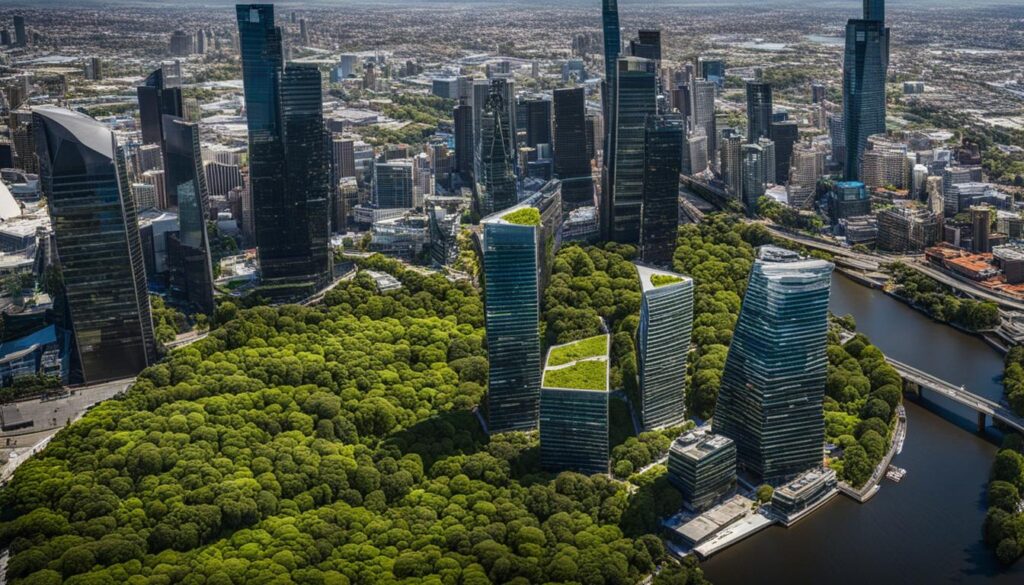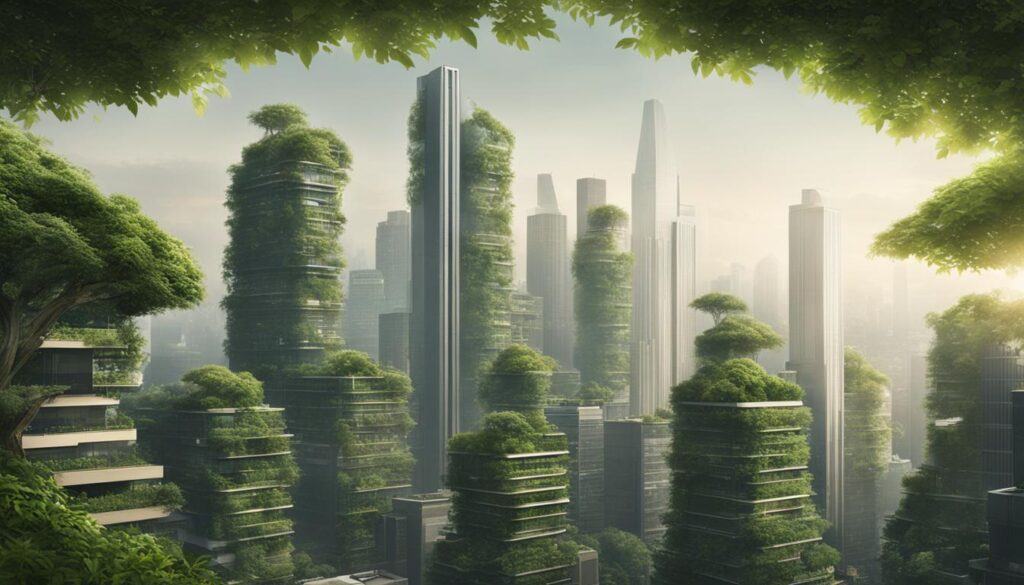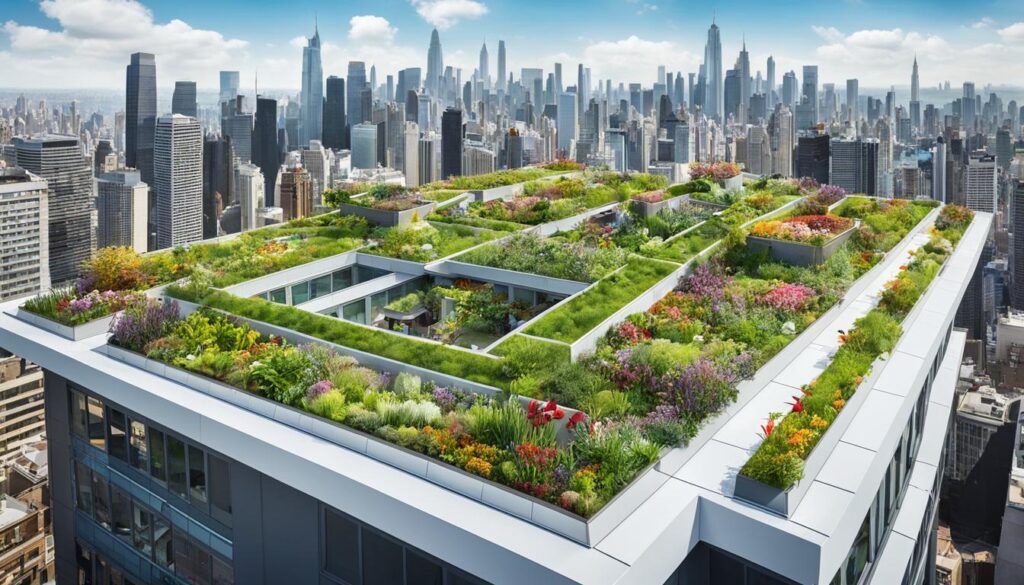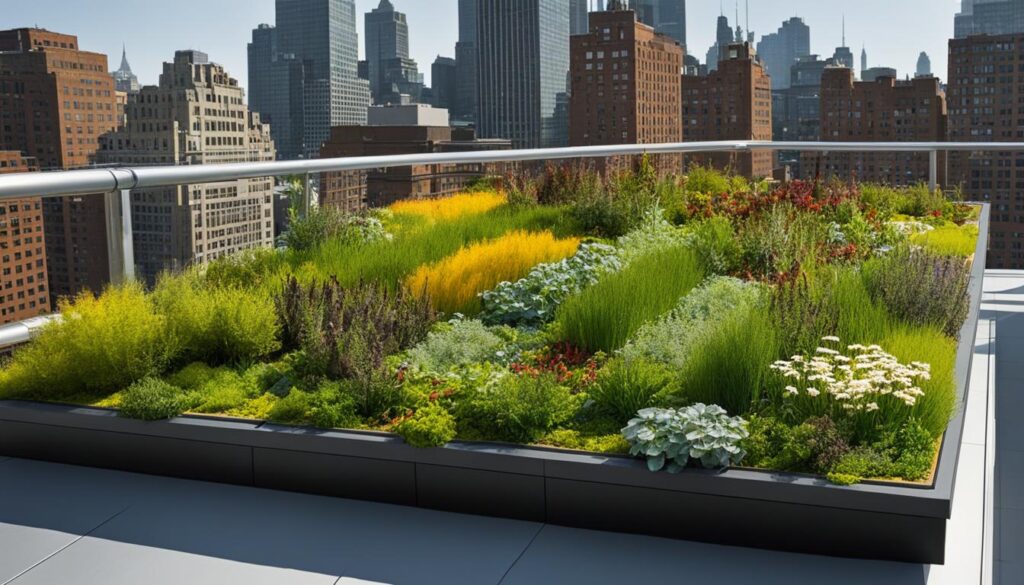In recent years, Melbourne’s Green Roof Initiative has gained significant attention for its impact on urban biodiversity and sustainability efforts. Green roofs, also known as living roofs or rooftop gardens, are transforming the city’s skyline, offering a promising solution to mitigate the negative effects of urbanization on local ecosystems.
Key Takeaways
- Melbourne’s Green Roof Initiative enhances urban biodiversity
- Green roofs support the preservation and promotion of urban ecological systems
- Urban green spaces play a crucial role in maintaining urban biodiversity and providing essential ecosystem services
- Green roofs act as potential habitats for urban wildlife, contributing to overall biodiversity conservation
- Monitoring and evaluating the impact of Melbourne’s Green Roof Initiative is crucial to assess its effectiveness and identify opportunities for further expansion
Enhancing Urban Biodiversity through Green Roofs
Green roofs have become an important component of sustainable urban development. They provide an opportunity to enhance urban biodiversity, contributing to the preservation and promotion of urban ecological systems. The benefits of green roofs are far-reaching, providing an example of how innovative solutions can address urban environmental challenges.
Urban Biodiversity
Urban biodiversity refers to the variety of plant and animal species found in urban areas. While cities are often associated with concrete and steel, they are also home to unique ecological systems that play a vital role in maintaining the health of our planet. These systems, which include green spaces, parks, and other urban landscapes, are essential for supporting biodiversity and mitigating the impact of climate change.
| Green Roof Benefits | How It Enhances Urban Biodiversity |
|---|---|
| Increases Green Space in Urban Areas | Provision of habitat and food for plant and animal species |
| Reduces Urban Heat Island Effect | Eases thermal stress, particularly for insects, birds and other animals |
| Improves Air Quality | Reduces particulate matter in the air, and absorbs atmospheric pollutants |
| Manages Stormwater | Retains water that can be used for plant growth and increases infiltration |
Green Roofs and Biodiversity
Green roofs provide a unique opportunity to promote biodiversity in urban areas. By incorporating native plant species into green roofs, we can create habitats for a range of wildlife, including birds, bees, and butterflies. Additionally, green roofs can provide a stepping stone for species to move between fragmented urban habitats, helping to maintain overall population sizes and genetic diversity.
Conclusion
The integration of green roofs into urban landscapes is an innovative approach towards promoting sustainable urban development. Not only do they provide numerous environmental benefits, but they also enhance the urban biodiversity of our cities. By increasing green spaces, promoting native plant species, and creating habitats for wildlife, green roofs play a vital role in shaping the sustainable cities of the future.
The Role of Urban Green Spaces
Urban green spaces are an essential component of sustainable urban ecosystems and provide crucial ecosystem services to our cities. As urban areas continue to expand, the preservation and creation of green spaces play a vital role in maintaining urban biodiversity and supporting the health and well-being of our communities.
Green spaces in urban areas provide a range of important ecosystem services, such as air purification, climate regulation, and natural stormwater management. They help in reducing urban heat island effects and providing habitats for urban wildlife. Urban green spaces also offer recreational opportunities, providing residents with areas for physical activity and relaxation.
The presence of green spaces in urban areas has been linked to improved mental health, reducing stress levels and promoting mental well-being. Studies have shown that exposure to nature and green spaces can improve cognitive function and boost the immune system.
Our cities and communities benefit from the presence of urban green spaces, where they are providing essential ecosystem services as well as opportunities for leisure and recreation.
Types of Urban Green Spaces
Urban green spaces can come in various forms, ranging from small pocket parks to large public parks and gardens. Green roofs and walls are also becoming increasingly popular as urban green spaces, playing a crucial role in urban biodiversity and sustainability efforts. Green roofs reduce the urban heat island effect and provide habitats for various wildlife, including birds and insects.

Benefits of Urban Green Spaces
| Benefits | Explanation |
|---|---|
| Biodiversity Conservation | Urban green spaces provide habitats for a variety of plant and animal species, supporting urban biodiversity conservation. |
| Air Quality Improvement | Urban green spaces act as sinks, filtering harmful toxins and pollutants from the air, providing cleaner air to breathe. |
| Climate Regulation | Urban green spaces help regulate the urban climate, reducing the urban heat island effect and mitigating the effects of climate change. |
| Stormwater Management | Green spaces help prevent stormwater run-off, reducing the risk of flooding and safeguarding water quality in rivers and streams. |
| Recreation and Leisure | Green spaces provide residents with opportunities for relaxation, physical activity, and social interaction, contributing to overall well-being and community building. |
Urban green spaces play a significant role in providing essential ecosystem services, promoting biodiversity conservation, and supporting our communities’ health and well-being.
Understanding Urban Ecological Systems
Urban ecological systems encompass the ecosystems and living organisms within urban environments. They consist of both natural and built environments and the complex interactions between them. Urban ecological systems are vital for maintaining the health and well-being of urban residents. They provide crucial ecosystem services, including air and water purification, climate regulation, and waste management.
One of the essential components of the urban ecological system is green infrastructure, which includes green roofs, parks, and gardens. Green infrastructure provides numerous benefits, including reducing the urban heat island effect, managing stormwater, and promoting biodiversity.
To support the development of green infrastructure, it is necessary to first understand the challenges and essential components of urban ecological systems. This involves mapping out urban ecosystems and identifying areas in need of conservation or restoration. It also requires an understanding of the social, economic, and environmental forces that impact urban ecological systems.
The Role of Green Infrastructure in Supporting Biodiversity
Green infrastructure plays a crucial role in supporting urban biodiversity. It provides habitat for a variety of plant and animal species, promoting biodiversity conservation within urban environments. Green roofs, in particular, provide an opportunity for promoting the growth of native plant species, supporting the survival of local flora and fauna.
The Importance of Integrating Green Infrastructure into Urban Planning
To fully comprehend the benefits of green infrastructure, it is critical to integrate it into urban planning and decision-making processes. The use of green infrastructure can help mitigate the negative impacts of urbanization on urban ecosystems. It can also promote the sustainability of urban development by supporting the preservation and restoration of valuable ecosystems within the city.
“Green infrastructure can help urban planners to create more sustainable and resilient cities, which can better support biodiversity and the health and well-being of urban residents.”
Overall, the proper understanding of urban ecological systems and the impact of green infrastructure on urban biodiversity is essential in promoting sustainable urban development. Green infrastructure provides numerous benefits, from reducing pollution and mitigating environmental challenges to promoting community engagement in urban sustainability efforts.
The Benefits of Melbourne’s Green Roof Initiative
Melbourne’s Green Roof Initiative has brought numerous benefits to our city, contributing to a more sustainable future. The initiative involves the installation of vegetated roofs atop buildings, providing a range of environmental and economic advantages.
Improved Air Quality
In urban areas, air pollution levels can have detrimental effects on public health. Green roofs help improve air quality by filtering particulate matter and absorbing pollutants, such as nitrogen dioxide and carbon monoxide. Studies have shown that green roofs can reduce ambient air temperatures and improve air quality in the surrounding areas.
Reduced Urban Heat Island Effect
Urban heat islands occur when built-up areas experience higher temperatures than surrounding rural areas due to human activities. Melbourne’s Green Roof Initiative helps mitigate this effect by providing green spaces to absorb heat and cool the city. By promoting rooftop vegetation, the initiative reduces the dependence on energy-hungry air conditioning systems and improves thermal comfort, especially during summer months.
Stormwater Management
Urbanisation often leads to increased stormwater runoff, causing water pollution and flooding. Green roofs help manage stormwater by absorbing rainwater and reducing runoff volume. This reduces the burden on existing drainage systems, minimising the occurrence and intensity of floods and erosion. Additionally, the vegetation and soil on green roofs help remove pollutants from the water, improving water quality and protecting ecosystems downstream.

“Green roofs have a multitude of benefits, including reduced energy consumption, improved air quality, and increased biodiversity. Melbourne’s Green Roof Initiative plays a critical role in ensuring the city’s long-term sustainability and resilience.” – City Council Spokesperson
Promoting Native Plant Species
At the heart of Melbourne’s Green Roof Initiative is the promotion of urban biodiversity. Green roofs provide an opportunity to promote the growth of native plant species, which support the preservation and re-introduction of local flora and fauna.
Native plant species have evolved to thrive in local environments and are essential to urban ecosystems. They provide food and habitat for wildlife and support the pollination of flowering plants. Encouraging the growth of these plant species on green roofs helps to promote urban biodiversity.
Additionally, the use of native plant species on green roofs can improve the resilience of urban ecosystems to climate change. Adapted to the local climate, these plants require less maintenance, water, and fertilizers, making them a more sustainable choice for green roofs.
Diversity of Native Plant Species on Green Roofs
Research has shown that green roofs have the potential to support a diverse range of native plant species. A study conducted in the UK found that extensively planted green roofs had higher levels of plant diversity compared to intensively planted roofs.
The diversity of plants can also be influenced by the design and maintenance of green roofs. The use of specialized substrates and irrigation systems can help to create a more suitable environment for native plant species to grow. Additionally, incorporating different plant types and creating microhabitats on green roofs can promote biodiversity and support the establishment of a more resilient ecosystem.
Creating Habitat for Wildlife
Green roofs have immense potential in providing an opportunity for habitat creation for urban wildlife, which contributes to overall biodiversity conservation. With appropriate design and maintenance, green roofs can become havens for a variety of animal and insect species, such as birds, bees, butterflies, and small mammals, among others.
Green roofs provide a vital space for urban wildlife to live, feed, and reproduce, amplifying urban biodiversity. These green spaces act as an oasis for animals in an otherwise concrete-dominated environment, providing the necessary food, shelter, and breeding grounds to sustain animal populations.

“Green roofs support various forms of wildlife, including invertebrates, birds, and small mammals.”
Moreover, the incorporation of native plant species in green roofs promotes biodiversity by providing suitable habitats and food sources for local fauna. Bees and other pollinators find their nectar in flowering plants found in green roofs, while birds and other wildlife feed on the insects attracted to these plants. Native species also encourage the growth of the local ecosystem and enhance the stability of the environment.
Green roofs are a valuable tool in promoting habitat creation for urban wildlife, and their incorporation in urban planning can help support and conserve biodiversity in cities across Australia.
Mitigating Urban Environmental Challenges
Melbourne’s Green Roof Initiative is not only beneficial for enhancing urban biodiversity, but it also helps in mitigating various environmental challenges faced by urban areas. The benefits of green roofs extend beyond aesthetic appeal and add to the long-term sustainability of cities.
One of the significant advantages of green roofs is their ability to mitigate air and water pollution. The vegetation and substrate of green roofs act as a natural filter for pollutants in the air, resulting in cleaner air quality for the surrounding areas. Additionally, green roofs can help retain rainwater in their substrate, reducing the risks of flash floods and decreasing the amount of polluted water entering the city’s waterways.
Beyond environmental benefits, green roofs also have a positive impact on the energy consumption of buildings. Vegetation on green roofs provides insulation, reducing the energy required for heating and cooling buildings. Lowering energy consumption helps in reducing greenhouse emissions, promoting a more sustainable future for our cities.
Melbourne’s Green Roof Initiative is playing a crucial role in sustainable urban development, creating awareness among individuals, community groups, and organizations. By supporting the initiative, we can work towards mitigating environmental challenges and promoting sustainable city development.
Engaging Communities in Urban Sustainability
At the heart of Melbourne’s Green Roof Initiative is a commitment to engaging communities in sustainable urban development. By promoting the installation of green roofs across the city, we encourage residents to become active participants in creating a greener and more biodiverse urban landscape.
Green roofs offer an opportunity to foster community engagement in urban sustainability efforts by providing a hands-on approach to sustainable urban development. By involving residents in the installation and maintenance of green roofs, we can create a sense of ownership and pride in our neighbourhoods, while also building a deeper understanding of the benefits of green infrastructure.
Moreover, green roofs offer a space for communities to come together and connect with nature. They provide an opportunity to create shared spaces for residents to enjoy and promote social interaction. As such, green roofs are not just about enhancing urban biodiversity but also about building stronger, more connected and sustainable communities.
One of the remarkable examples demonstrating community involvement in the Melbourne’s Green Roof Initiative is the Federation Square complex in the city center. With over 3,000 square metres of green roof, Federation Square has created a unique, biodiverse public space for residents and visitors.
“Federation Square’s green roof is a beautiful example of how urban spaces can be transformed into biodiverse public areas. The green roof provides an ecological oasis in the heart of the city that contributes to Melbourne’s sustainability efforts. It is wonderful to see how the Federation Square inspires and engages communities in the city’s green roof initiative,” states Jane Smith, an environmental activist in Melbourne.
Monitoring and Evaluating Green Roof Impact
At Melbourne’s Green Roof Initiative, we understand that monitoring and evaluating the impact of our projects is crucial to assess their effectiveness. By doing so, we can improve and refine our work, ensuring that we continue to promote biodiversity and sustainability in our City.
To evaluate the impact of our green roof projects, we employ various methodologies that measure the positive outcomes of the project. These measures include:
| Data Collected | Measurements Conducted |
|---|---|
| Changes in air quality | – Measuring levels of Co2, nitrous oxide, and particulate matter |
| Reduction in urban heat island effect | – Measuring temperature differences between the green roof and surrounding areas |
| Improvement in stormwater management |
– Measuring the amount of water runoff – Collecting and testing water samples for pollutants |
| Impact on local flora and fauna | – Conducting surveys to observe the growth and behavior of plants and animals on the roof |
Through our monitoring and evaluation procedures, we have gathered valuable information that showcases the benefits of our green roof projects. Our initiative has demonstrated reductions in air pollutants, temperature differences in urban areas, and improvements in stormwater management, among other benefits.
“We believe that ongoing monitoring and evaluation of our green roof impact is essential for demonstrating a successful initiative and to inspire further projects that promote urban biodiversity and sustainability.” – Melbourne’s Green Roof Initiative
We believe that ongoing monitoring and evaluation of our green roof impact is essential for demonstrating a successful initiative and to inspire further projects that promote urban biodiversity and sustainability. By measuring our success, we can improve and promote green roof benefits that, in turn, support and strengthen our communities, environment, and future.
Potential for Future Expansion
We believe that Melbourne’s Green Roof Initiative has significant potential for further expansion in the future to enhance sustainable urban development and urban biodiversity. As more cities recognize the critical role of green roofs in transforming urban and ecological systems, their implementation across the globe has been on the rise.
Expanding the implementation of green roofs can lead to long-term benefits such as:
| Benefits of Green Roof Expansion | |
|---|---|
| Promoting biodiversity through increased green space | 🌿 |
| Improving urban air quality | 🍃 |
| Reducing Urban Heat Island effect | 🌡️ |
| Managing stormwater effectively | 🌧️ |
| Saving energy | 💡 |
The potential expansion of green roofs in Melbourne can bring awareness and engagement in urban sustainability efforts across communities, creating local job opportunities, and boosting the city’s economy through the adoption of green technologies and nature-based solutions.
Through expanding Melbourne’s Green Roof Initiative, we can create a greener and more sustainable future for our city.
The Impact of Melbourne’s Green Roof Initiative on Urban Biodiversity
Throughout this article, we have explored the various benefits of Melbourne’s Green Roof Initiative in enhancing urban biodiversity and promoting sustainable urban development. The initiative’s impact is evident in numerous ways, from creating habitats for urban wildlife to mitigating environmental challenges.
Through the implementation of green roofs, Melbourne is reshaping its urban landscape to promote ecological systems’ preservation and improvement. This initiative supports the growth of native plant species, ultimately contributing to the conservation of local flora and fauna. Moreover, green roofs act as potential habitats for a variety of animal and insect species, thus promoting overall biodiversity conservation.
Melbourne’s Green Roof Initiative also plays a crucial role in mitigating various environmental challenges, including air and water pollution. Green roofs absorb pollutants, reducing the amount of greenhouse gases and contaminants in the atmosphere. By reducing energy consumption, Melbourne’s Green Roof Initiative helps reduce the urban heat island effect, thus improving air quality.
The initiative fosters community engagement in urban sustainability efforts, raising awareness and encouraging active participation among residents. Engagement in urban sustainability efforts is essential in promoting sustainable urban development, and the implementation of green roofs helps accomplish this.
Monitoring and evaluating the impact of Melbourne’s Green Roof Initiative is critical in assessing its effectiveness in promoting biodiversity and sustainability. The methodologies employed to measure the success of this initiative will provide valuable insights into the potential for further expansion and integration into future urban development plans.
In conclusion, Melbourne’s Green Roof Initiative plays a vital role in enhancing urban biodiversity and reshaping the city’s sustainability efforts. Through the promotion of native plant species, creation of wildlife habitats, and mitigation of environmental challenges, green roofs contribute to a greener and more resilient urban landscape.
FAQ
What is Melbourne’s Green Roof Initiative?
Melbourne’s Green Roof Initiative is a program aimed at increasing the number of green roofs in the city. It encourages the installation and maintenance of rooftop gardens and vegetation to enhance urban biodiversity and sustainability.
What are the benefits of green roofs for urban biodiversity?
Green roofs provide a range of benefits for urban biodiversity. They create habitats for native plant species and wildlife, contribute to the preservation of urban ecological systems, and help mitigate environmental challenges such as air pollution and stormwater management.
How do green roofs contribute to sustainable urban development?
Green roofs play a significant role in sustainable urban development by providing ecosystem services such as improved air quality, reduced urban heat island effect, and energy conservation. They also engage communities in urban sustainability efforts and promote awareness and active participation.
What is the role of urban green spaces in maintaining urban biodiversity?
Urban green spaces, including green roofs, play a crucial role in maintaining urban biodiversity. They provide necessary habitat for plant and animal species, contribute to the overall functioning of urban ecological systems, and enhance the ecological resilience of cities.
How are urban ecological systems interconnected with green infrastructure?
Urban ecological systems are interconnected networks of natural and human-made elements in urban environments. Green infrastructure, including green roofs, forms an integral part of these systems by providing green spaces, connecting habitats, and supporting the flow of ecosystem services.
What are some specific benefits of Melbourne’s Green Roof Initiative?
Melbourne’s Green Roof Initiative brings several benefits to the city, including improved air quality, reduced urban heat island effect, stormwater management, and increased biodiversity. It also promotes sustainable urban development and community engagement in urban sustainability efforts.
How do green roofs promote the growth of native plant species?
Green roofs provide a suitable environment for the growth of native plant species. By creating habitats for these plants, green roofs contribute to their preservation, support local fauna, and enhance urban biodiversity.
How do green roofs create habitat for wildlife?
Green roofs act as potential habitats for a variety of urban wildlife, including birds, insects, and small mammals. These rooftop spaces provide food sources, nesting areas, and refuges, contributing to overall biodiversity conservation.
How do green roofs help mitigate urban environmental challenges?
Green roofs help mitigate urban environmental challenges by reducing air and water pollution. They filter pollutants from the air, absorb stormwater runoff, and help regulate urban temperatures, thus reducing the energy consumption and environmental impact of buildings.
How does Melbourne’s Green Roof Initiative engage communities in urban sustainability?
Melbourne’s Green Roof Initiative fosters community engagement in urban sustainability efforts by promoting awareness and active participation. It encourages residents to get involved in the installation and maintenance of green roofs, thereby creating a sense of ownership and environmental stewardship.
How is the impact of Melbourne’s Green Roof Initiative monitored and evaluated?
The impact of Melbourne’s Green Roof Initiative is monitored and evaluated through various methodologies. These may include measuring biodiversity indicators, assessing the performance of green roofs in terms of ecosystem services, and gathering feedback from the community and stakeholders.
What is the potential for future expansion of Melbourne’s Green Roof Initiative?
Melbourne’s Green Roof Initiative has great potential for further expansion and integration into future urban development plans. As the benefits of green roofs become more widely recognized, there is an opportunity to increase the number of green roof projects and amplify their long-term positive impact on urban biodiversity and sustainability.
What is the impact of Melbourne’s Green Roof Initiative on urban biodiversity?
Melbourne’s Green Roof Initiative has a significant impact on urban biodiversity. By promoting the growth of native plant species, creating habitats for wildlife, and enhancing the overall ecological resilience of the city, green roofs contribute to the preservation and promotion of urban biodiversity.
